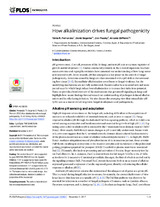How alkalinization drives fungal pathogenicity
Autor
Ribeiro Fernandes, Tânia Alícia
Segorbe, David
Prusky, Dov
Di Pietro, Antonio
Editor
Public Library of ScienceFecha
2017Materia
Plant fungal pathogensFungal pathogens
MAPK signaling cascades
Fungi
Ammonia
Fungal diseases
Pathogenesis
Rice blast fungus
METS:
Mostrar el registro METSPREMIS:
Mostrar el registro PREMISMetadatos
Mostrar el registro completo del ítemResumen
pH governs most, if not all, processes of life. In fungi, ambient pH acts as a potent regulator of
growth and development [1]. Studies conducted primarily in the 2 model organisms Saccharomyces
cerevisiae and Aspergillus nidulans have cemented our understanding of how fungi sense
and respond to pH. More recently, pH has emerged as a key player in the control of fungal
pathogenicity. Infections caused by fungi are often associated with a pH shift in the surrounding
host tissue [2±4]. Extracellular alkalinization contributes to fungal virulence, but the
underlying mechanisms are not fully understood. Recent studies have revealed new and unexpected
ways by which fungi induce host alkalinization to increase their infectious potential.
Here, we provide a brief overview of the mechanisms that govern pH signaling in fungi and
highlight how recent findings have advanced our understanding of pathogen-induced alkalinization
and its role during infection. We also discuss the emerging view that intracellular pH
(pHi) acts as a master switch to govern fungal development and pathogenicity.

